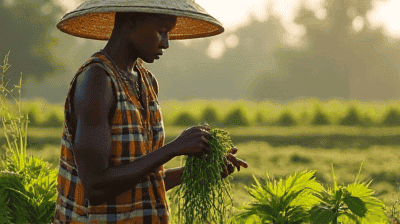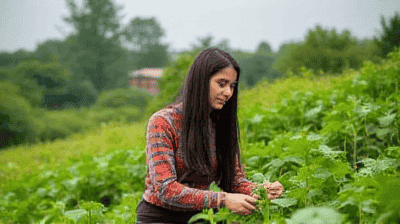
Sustainable agriculture faces numerous challenges in the modern world, including climate change, loss of biodiversity, soil degradation, and food insecurity. As we seek solutions to these pressing issues, there is a growing interest in indigenous farming techniques, which have been practiced for thousands of years. These methods, rooted in deep ecological knowledge and understanding of local ecosystems, often outperform modern industrial agricultural methods in sustainability, resilience, and environmental impact.
Indigenous farming techniques encompass traditional agricultural practices developed by indigenous peoples around the world. These practices are often closely linked to cultural identity and community values, characterized by a holistic understanding of nature and an intimate relationship with the land. Indigenous farming is based on ancestral knowledge passed down through generations and adapted to local ecological contexts.
Sustainability: Indigenous practices prioritize long-term ecological health, aiming to maintain soil fertility, protect biodiversity, and conserve water resources.
Agroecological Knowledge: Indigenous farmers possess deep knowledge of local ecosystems, including soil types, climate patterns, and plant behaviors.
Biodiversity: Indigenous methods often involve growing a diverse array of crops and plants, fostering resilience against pests, diseases, and climate variability.
Community-Centered Approaches: Indigenous farming is often community-based, emphasizing collaboration, knowledge sharing, and the importance of cultural heritage.
Adaptive Management: Indigenous farmers utilize adaptive management strategies, allowing them to respond to environmental changes and uncertainties effectively.

Indigenous farming techniques vary greatly depending on geographical location and cultural practices. Here are several examples of successful indigenous methods that demonstrate their effectiveness:
One of the most famous indigenous agricultural techniques comes from Native American cultures and involves the cultivation of the "Three Sisters"—corn, beans, and squash. This intercropping approach exemplifies how complementary plants can enhance ecosystem health:
This polyculture system promotes biodiversity, enhances soil fertility, and reduces the risk of crop failure.
Commonly practiced by indigenous communities in tropical regions, shifting cultivation involves the temporary clearing of forested land for agriculture. Farmers grow crops for a period, then move to a new area, allowing the previous site to regenerate. Key features of this practice include:
Unlike modern industrial farming methods that rely on continuous use of land and heavy chemical inputs, shifting cultivation embraces a natural cycle of use and regeneration.
In the Andean region, indigenous farmers have developed intricate terracing systems to cultivate crops on mountainous terrain. This technique includes building stone or earthen walls to create flat surfaces for planting. Its advantages include:
Terracing exemplifies how indigenous peoples have transformed challenging landscapes into productive agricultural areas while preserving the environment.
The milpa system, practiced by indigenous peoples in Mesoamerica, is a form of shifting cultivation that includes a mix of crops grown in a single area. Key characteristics of the milpa system include:
The milpa system enhances resilience, increases food security, and promotes biodiversity, all while maintaining ecological balance.
Indigenous communities around the world have long practiced agroforestry, an approach that integrates trees and shrubs into agricultural landscapes. This technique offers several benefits:
Agroforestry exemplifies how indigenous methods can dramatically enhance both agricultural productivity and ecosystem health.
Modern industrial agriculture often prioritizes short-term yields at the expense of long-term sustainability, resulting in several negative environmental impacts:
Soil Degradation: Intensive tillage and monoculture lead to soil erosion, loss of organic matter, and reduced fertility over time. In contrast, indigenous practices prioritize soil health through crop diversity, soil conservation, and regenerative techniques.
Biodiversity Loss: Industrial agriculture relies on a limited number of crops, leading to monocultures that reduce biodiversity and increase vulnerability to pests and diseases.
Chemical Dependence: Modern farming methods often depend on synthetic fertilizers and pesticides that can harm ecosystems, pollute waterways, and adversely affect human health. Indigenous practices emphasize natural methods, reducing the need for harmful chemicals.
Cost-Effectiveness: Indigenous farming methods can provide economic viability through low-input systems. By relying on local resources and traditional knowledge, indigenous techniques often require fewer external inputs compared to industrial methods.
Local Resilience: Indigenous practices strengthen local economies by promoting food sovereignty and self-sufficiency, reducing reliance on global supply chains vulnerable to disruptions.
Long-Term Stability: While modern industrial agriculture often focuses on short-term profits, indigenous practices promote long-term sustainability and resilience, ensuring that communities can continue to produce food for generations.
Cultural Heritage: Indigenous farming techniques are often tied to cultural identity and heritage, fostering community cohesion and preserving ancestral knowledge. Modern industrial agriculture, however, can displace traditional practices and erode cultural connections to the land.
Community-Based Approaches: Indigenous farming emphasizes community engagement and collaboration, promoting collective action in food production. In contrast, industrial methods can lead to individualism and competition, undermining social networks.

As we strive for a more sustainable food system, there are valuable lessons to be learned from indigenous farming techniques:
Incorporating diverse crop systems can improve agricultural resilience and reduce vulnerability to pests and diseases. By promoting biodiversity, modern agriculture can enhance food security and ecosystem health.
Building soil health through organic practices, cover cropping, and reduced tillage aligns with indigenous principles. Healthy soils contribute to strong ecosystems and produce nutrient-dense food.
Valuing and integrating traditional ecological knowledge can enhance sustainable agricultural practices. Collaborating with indigenous communities can foster innovation and efficiency in modern farming methods.
Agroecology blends traditional practices with modern science, focusing on sustainable farming that respects local ecosystems. This approach can help inform more resilient food systems globally.
Promoting local food production and community engagement can strengthen food sovereignty and empower communities. By investing in local agriculture, we can foster resilience and reduce reliance on industrialized systems.
Indigenous farming techniques offer a wealth of knowledge and practices that can significantly improve the sustainability and resilience of modern agriculture. By valuing biodiversity, emphasizing soil health, and integrating traditional ecological knowledge, we can create agricultural systems that honor the environment while providing food security for future generations.
As we seek to address the pressing challenges of climate change, food insecurity, and environmental degradation, it is essential to recognize and learn from the wisdom of indigenous peoples. By harnessing the power of indigenous farming techniques, we can pave the way for a more sustainable, equitable, and resilient food system that benefits both people and the planet.